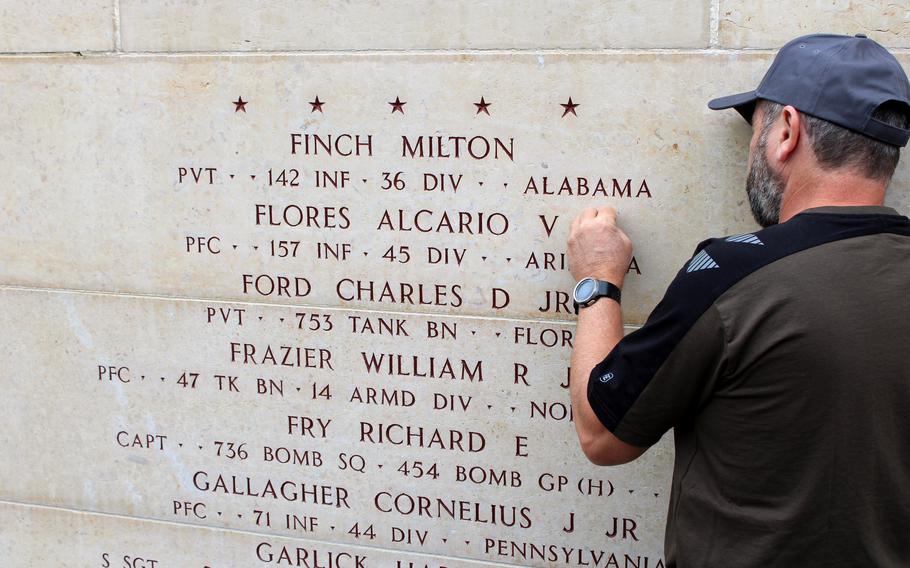
An American Battle Monuments Commission staff member places a bronze rosette next to the name of U.S. Army Pfc. Alcario V. Flores on the Wall of the Missing on July 23, 2024, at the Epinal American Cemetery in Dinozé, France. The rosette signifies that Flores has been accounted for. (American Battle Monument Commission)
A pair of World War II memorials in France inscribed with the names of missing American troops had a bronze marker added to them this week, signifying that two more U..S. service members had been accounted for.
On Wednesday, the American Battle Monuments Commission placed a rosette next to the name of Army Cpl. Robert A. Bartlett on the Wall of the Missing at Normandy American Cemetery in Colleville-sur-Mer.
A day earlier, another marker was inserted near the name of Pfc. Alcario V. Flores on a similar wall at the Epinal American Cemetery in Dinozé, in northeastern France.
They’re the latest in a recent uptick in positive identifications by the Defense POW/MIA Accounting Agency of American military personnel who fought in Europe decades ago.
The two soldiers were accounted for separately earlier this year and will be repatriated to their families for private burials in early August, the commission said in separate statements Wednesday.
Bartlett from Pierre, S.D., was 22 when he died. He was assigned to the 744th Tank Battalion and was part of the crew of an M5A1 Stuart light tank, according to Defense Department records.
A German rocket hit his tank near Saint-Germain-d’Elle, France, in July 1944. Two crew members managed to escape, but Bartlett and another soldier were never heard from again, according to the records.
The Defense POW/MIA Accounting Agency announced July 18 that Bartlett’s remains had finally been identified.
Days before, the agency announced that Flores had been accounted for as well.
A resident of Coolidge, Ariz., and assigned to the 45th Infantry Division, Flores was killed on Jan. 21, 1945, during a battle with German forces near Reipertswiller, France, according to the agency. He was said to have been 37 when he died.
The American Battle Monuments Commission operates and maintains 26 cemeteries and 31 federal memorials throughout the world. More than 200,000 Americans buried and memorialized at the sites.
On its monuments to service members missing in action, the commission places bronze rosettes next to the names of those who are later accounted for. The rosettes display a laurel wreath and the eight points of a compass.
“It signifies America’s commitment, reaching out in all directions to recover their remains from the farthest corners of the earth,” according to the commission’s official description.
Bartlett’s rosette is the 29th on the Wall of the Missing at Normandy, which includes the names of more than 1,550 service members, many of whom were lost at sea.
Flores’ rosette is the 33rd on the Epinal American Cemetery’s wall, which lists more than 420 troops, the commission said.
They’re among a handful of recently added rosettes.
Last week, one was placed next to the name of Army Pvt. William A. Smith on Normandy’s wall. Smith from Syracuse, Mo., was 21 when he went missing. He was assigned to the 149th Engineer Combat Battalion in the European theater.
According to Defense Department records, he was on a landing craft that struck an underwater mine en route to Normandy’s Omaha Beach on D-Day, and his remains were eventually uncovered during an examination of the wreckage.
On Friday, the ABMC announced on X, formerly known as Twitter, that a rosette had been added next to the name of Army Pfc. Lemuel Dent Jr. on the Wall of the Missing at Florence American Cemetery in Tavarnuzze, Italy.
Dent of Ironsides, Md., was in a tank that took enemy fire near the Cinquale Canal in northwestern Italy in early 1945. He was assigned to the 92nd Infantry Division and was 30 when he died.
Army Pfc. Harry Hosfelt and Army Air Forces 2nd Lt. Allan Knepper, two other soldiers who went missing in Italy during World War II, had rosettes placed next to their names on the Wall of the Missing at Sicily-Rome American Cemetery in Nettuno, Italy, last week.
And last month, 1st Lt. Nathan Baskind, a Jewish American who was killed in France during the war and mistakenly buried in a mass grave for German soldiers, was given a proper burial at Normandy American Cemetery.
Afterward, a relative of the Pittsburgh native helped place a rosette next to his name on the Wall of the Missing.
Officials attribute the spike in identifications to technological advances and improvements in DNA analysis.
The rosette for Baskind was the fifth added to the Normandy American Cemetery’s wall in as many months, superintendent Scott Desjardins said.
“Why are we moving so fast? Technology, DNA,” Desjardins said on the sidelines of the ceremony. “We hope in the future that we can find a lot of these men and put a rest to their story and give their families some peace.”